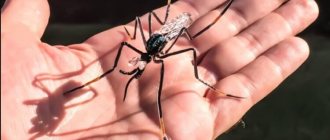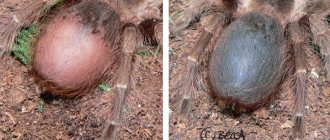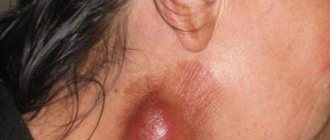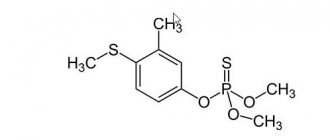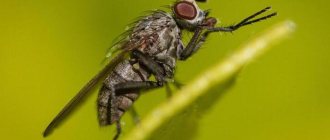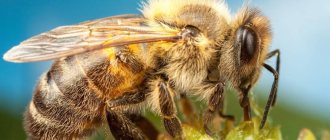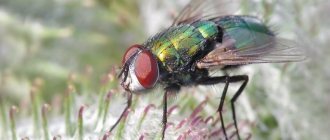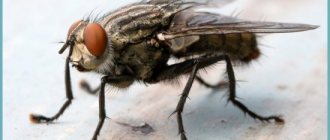South Polybia
The wasp family includes many species. These insects have a very wide habitat. The species Polybiinae Occidentalis (Polybia Occidentalis) is found in the southern states of the USA, Mexico and northern Latin America. These wasps are surprisingly similar in habits to hardworking bees. These insects do more than just pollinate flowers with their furry bodies. They also collect, digest and store flower nectar in honeycombs. And the question of whether there is wasp honey can be answered with confidence in the affirmative. The Indians of Yucatan ate the product of processing nectar from the nests of Polybia Occidentalis long before the arrival of Columbus's ships. However, the natives of America did not raise apiaries. They simply collected honey from wasp nests. This product is not as sweet as bee, but still tasty and nutritious. By the way, there is much less honey in the nest. Perhaps because in the tropical climate, Southern Polybia does not need to accumulate it in reserve.
Scolia wasps
Scolia are representatives of one of the largest family of wasps. These insects reach a size of 6 mm to 10 cm; females are much larger and tougher than males. In females of some species, the tips of the wings are purple, and the body is black with yellow, white or orange spots. Scolia wasps lead a solitary life and feed on flower nectar. They feed their offspring with the larvae of other insects.
Despite its impressive size, encountering this species is almost not dangerous; the sting of these wasps is not so painful, and the poison is not very toxic. Moreover, these wasps prefer not to enter into conflict when in contact with humans and destroy harmful insects. Also, wasp venom is often used in medicine.
Features of life
To find out whether wasps make honey, you must first figure out whether they need it. In most cases we are talking about adults. Adults feed on nectar, juices of ripe vegetables and fruits, but for the larvae they obtain protein food - spiders, flies, small insects, bees.
Wasps prefer to eat honey, but not make it. Many families attack bee hives, completely destroy the reserves at one time, and drag the “captives” to feed their larvae. Honey is not carried into the nest, so there is no honey as such in the honeycombs.
However, a small layer of sticky mass, reminiscent of a beekeeping product, accumulates on the walls of the cells. The question again is whether wasps make honey or not. Insects do not burden themselves with this mission; the coating occurs on its own, after the insect has been on the flower and feasted on the pollen.
Interesting!
In the countries of America and Africa there are several families of social wasps that collect honey and make it. But not in such numbers as usual bees, but only to feed themselves in the winter. To say that wasps do not make honey is also wrong.
It is also important that the wasps in our area do not hibernate in swarms. At the end of summer they leave the nest and fly away in different directions. With the onset of cold weather, metabolic processes in the body slow down, insects become slow and vulnerable. One part dies from natural enemies, the other from the cold. Only young fertilized females remain to spend the winter, whose mission will continue in the spring. In winter, insects fall into suspended animation - they simply sleep and do not need food supplies.
Bumblebee honey
Do wasps and bumblebees produce honey like bees? As for the first ones, everything is clear with them. Bumblebees collect flower nectar and process it to make honey. Since insects do not store volumes, the amount of sweetness is small. The main purpose of bumblebee nectar is to feed the larvae and support the vital processes of the entire hive.
Bumblebee
This product is very useful for humans, since its quantity is very limited, but the benefits for the body are undeniable. Bumblebee honey is a very expensive and rare product.
Few people mine it, and therefore it can be very difficult to find a seller. And yet it is quite possible to purchase this product; this can be done via the Internet.
The product is characterized by the following properties:
- its liquid consistency makes it look like syrup;
- the specific gravity of honey is very low;
- contains a variety of pollen (including plants such as purple damselfish and red clover);
- honeycombs have an unusual shape; in appearance they resemble jugs (however, their capacity is much less than the number of honeycombs).
The small amount of honey reserves is also explained by the short life span of these insects. They do not need to produce and stock the product in large volumes.
Note! Unlike wasps, bumblebees deliberately collect flower pollen in case it is not possible to obtain the required amount of juice directly from the flower.
Truth or myth?
There are many species of wasps and some of them actually accumulate honey in their hives. However, on the territory of Ukraine, Russia and the closest neighboring states it is impossible to find such a “find” in a hornet’s nest. This is due to the unsuitable climate and the lack of insect species that can produce honey. It is known for certain that honey wasps of the species Polybiinae Occidentalis live in Mexico and South America.
Polybia Occidentalis accumulates a considerable amount of honey in its hives. This property of yellow stripes was used in ancient times and currently by ethnic Indians living in South and North America. Gathering and beekeeping were among the most ancient occupations of the Mexican and South African Indian tribes. In addition, Polybia is such an ancient species that the idea of eating their honey came to settlers much earlier than the idea of breeding bees.
Otherwise, given the specifics of insects as a species, you cannot expect honey from them, because they provide just enough to feed themselves in the winter. Moreover, you should not expect it from ordinary inhabitants of gardens flying over our native expanses. The honey coating or “spray” in their nests is the result of nectar collection.
Wasp honey is essentially a very thick nectar. But they do not produce the enzymes that bees provide their sweetness. By the way, bees communicate with each other in a kind of “language” within the framework of a certain neural network. But wasps don’t do anything like that, and their level of development is an order of magnitude lower than their hardworking relatives. Therefore, the concept of “wasp honey” as such did not exist for the Slavs until a more detailed study of this type of insect.
Despite their honey uselessness, wasps are a very important part of the natural fauna. They use pest larvae to feed their offspring. Thus, stinging insects, which are so disliked by many, do a good deed for the garden and cultivated plants. For example, the burrowing or ground wasp is the worst enemy of mole crickets and their larvae. In order to attract these orderlies to the garden, farmers even plant flowering plants around the perimeter of the garden.
Wasps of the Amorphilla species are also useful - they actively destroy caterpillars of various species. In addition, wall, nose, paper and large-headed ones are excellent at clearing the garden of borers, leaf beetles, flies, cicadas and beetles. As you can see, a dangerous insect benefits nature, the harvest, and therefore provides a lot of benefits to humans.
Wasp honey and honey wasps - fact or fiction?
Does wasp honey exist, or can such a phrase be used only as a phraseological unit, as something impossible? Could any other insect have the unique ability of bees to transform flower nectar into a healthy food product?
Yes, there are little-known subfamilies of wasps that make honey in their nests. These unusual insects live in Mexico, Argentina and South America. One of the species is called the Mexican Honey Wasp (Mexican Honey Wasp, scientific name - Brachygastra mellifica). Another species is Polybiinae Occidentalis, these wasps are common in the southern United States, in the American tropics.
Honey wasps are the oldest insects. And even though their level of evolutionary development is much lower than that of bees, their honey has been enjoyed by the indigenous tribes of the American continent for many centuries. The collection of this delicacy can be called a primitive form of beekeeping, which preceded modern beekeeping. And nowadays there are also people who are familiar with the taste of wasp honey.
What does aspen honey taste like and why can’t it be found on sale?
Unlike bees, which produce large quantities of honey in the warm months of the year, honey wasps store such a small amount of sweet nectar in their nests that they only have enough of it for their own food during the winter months. It will not be possible to get a really large amount of honey from wasps, even if you gradually take away their reserves (as is done with bees), because wasps are not capable of working as hard as bees.
Wasp honey is essentially a very thick, sweetish mixture of pollen and nectar with a rich floral aroma, containing many nutritious plant components. Wasps, like bees, fly around all the flowering plants available to them in the area, trying to find food sources closest to their nest. Therefore, the taste of honey largely depends on the plants that grow near their home.
Despite the pleasant taste and smell, aspen honey is in many ways inferior to bee honey, and its nutritional value is low. It does not contain the enzymes with which bees convert the collected nectar into the honey familiar to our taste buds; in addition, it quickly loses its viscousness and crystallizes. Aspen honey is not nearly as sweet, and, of course, not as healthy. In fact, it is almost no different from the original nectar that the flower bud contains.
Do wasps give honey?
This question can only be answered positively in relation to insects belonging to 2 species living in the countries of South America, Argentina and Mexico:
- Polybia Occidentalis (Polybiinae Occidentalis);
- Mexican honey wasp (Brachygastra lecheguana).
They not only produce honey, but also store it for the winter, although its reserves are very meager compared to bees. The harvested product is barely enough to feed all family members.
If bees produce 15-17 kilograms of delicacy per season, then wasps are unable to collect even a kilogram.
Mexican honey wasps make nests from paper, which they obtain by chewing wood and treating it with sticky saliva. Their homes (they are usually located among citrus trees) can reach half a meter in diameter. They, like bees, make honeycombs, but not from wax, since they cannot produce such a substance.
Honey wasps, like bees, have a hierarchy. They have a queen, worker insects, warriors and drones. But in their development they are significantly inferior to their relatives.
A species of honey wasp
There are many types of insects, some of them actually produce honey, but in Russia, Ukraine and neighboring countries there are none.
Wasps that make honey live in Mexico and some countries in South America:
- Polybia are fairly large insects. They live in large colonies.
- Mexican honey plant. Despite the name, these insects can also be found in Brazil.
Aspen honey is quite nutritious and high in calories. It is high in calcium, protein, sucrose and minerals. It also has a rich floral aroma. It is collected the same way as 100 years ago - by hand. It is impossible to breed insects in apiaries: in such conditions they do not produce the product.
Wasp Polybia
Polybia accumulates a lot of honey in its honeycombs, rich in vitamins, minerals and antioxidants.
Wasps make nests in high tree crowns, the diameter of which reaches 0.5 m. Wasp honeycombs differ from bees in both size and composition. The wasp lacks the enzyme that produces wax, which is used to build the honeycomb.
The material from which the nests are made resembles paper. Wasps chew wood, plant stems and the top layer of bark of some trees, soaking them with saliva and thereby gluing them with the sticky secretion of the salivary gland.
The Polybia wasp is a predator. She does not feed her offspring with honey, like a bee, but feeds on small insects and feeds the larvae with processed product, so it is collected in large quantities.
Polybius
Mexican wasp
Mexican honey wasps, unlike other types of wasps, just like bees, live in a swarm, where each insect has responsibilities.
They have a hierarchy:
- uterus;
- workers;
- warriors;
- drones.
They also feed on small insects, but they deposit aspen honey in paper honeycombs. The Mexican loves to build nests in the crowns of citrus trees. This species leads a bee lifestyle. These are large, bright insects.
How wasps make honey
The two most common types of honey wasps are:
- Polybia occidantelis - this wasp species is geographically located in the United States and South America. For a long time, local residents have been eating the product of their production, which they produce in large quantities. The product is more like nectar. Wasps produce nectar primarily to feed their own hive, while aggressively defending themselves against attempts to enter it.
- Mexican honey wasp - localized in the United States of America. Their distinctive feature is honeycombs of non-standard shape. They build their paper hives in tree crowns; the diameter of the nest can reach half a meter. Wasps make their own paper for nests from chewed wood and moistened with their own saliva.
The way a wasp makes honey is different from the bee's process. Bees collect pollen with their proboscis, and wasps carry it to their hives on their legs. This causes a thin honey coating to form on the walls of their nests. Insects do not make any special efforts to produce it: wasps produce honey mainly to eat it themselves.
Also, these insects have a peculiar structure of glands in the pharynx, which are not capable of producing the enzymes necessary to convert nectar into the honey mass familiar to humans.
How honey is made from nectar
The collected and decomposed sweet solution remains in the honeycombs after processing. This whole process is called product ripening. The need for honey to mature is determined by the large amount of liquid contained in nectars. By the way, nectar can contain from 40 to 80% water in its composition. This level may vary depending on the climatic zone, weather conditions and characteristics of honey plants.
Honey collection
When transferred, the nectar is re-processed with enzymes, already in the body of non-flying bees. This process further dries the existing liquid. Additionally, during the harvest period, the hive is ventilated by the entire bee colony. The accumulated liquid slowly evaporates, forming a thickening syrup. To speed up the thickening process, working individuals blow it with flapping wings, like a fan. The syrup, which has the desired consistency, is actually the finished honey product. Now the full combs are hermetically sealed with wax plugs, which are made from flakes secreted by wax glands.
Making honey products is the main activity of striped insects. The productivity level of bee colonies may vary. It all depends on the distance between the location of the apiary and the honey sources. Good weather allows you to make at least 13 combined flights in a day, while the individuals manage to completely fill their goiter in no more than half an hour. It has been proven that with the right location, one family of insects can bring 20 kilograms of honey products to the hive per day.
Taste and color
Is wasp honey similar to bee honey? In general, yes, but it is produced only from pollen, without other components. Wasp honey accumulates in honeycombs, is distinguished by its fragrant, aroma, but goes through the crystallization process faster.
Wasps carefully study the area in search of suitable honey plants. It is important for them whether pollen can be collected from nearby flowers. Therefore, the composition of plants that are in close proximity to the hive plays an important role.
The wasp's honey ends up being dark brown, very sweet, with a pleasant smell of flowers, but inferior in various respects. Its nutritional value is low, since it does not contain bee enzymes that contribute to the enrichment of beneficial compounds, and there are no specific flavors.
By and large, there is no difference, honey or nectar, the product is similar to the raw material from a flower bud. You can eat this product completely calmly, unless you are talking about nectar from poisonous flowers - it can lead to intoxication and poisoning.
Features of honey
Aspen honey has a unique taste. It is different from the bee.
The bee's body produces enzymes that process pollen and nectar and make sweet and viscous honey. The wasp does not have such enzymes. The wasps make honey and store it in one side of the hive.
Wasps make dark brown honey. It is very fragrant and aromatic, since it mainly consists of a mixture of pollen and nectar, but has no viscosity, quickly crystallizes and dries out, but in this form is still edible. Wasps choose flowering plants that are close to the nest for pollination, so the taste of honey in each wasp comb differs in taste and smell.
Is it possible to eat wasp honey?
If the answer to the question “Do wasps collect honey?” positive, then another one naturally arises - “Can this product be eaten?” It turns out that South African and Mexican Indians have been collecting aspen honey since ancient times and using it for food purposes.
They have not given up this activity even in our time, although it is impossible to collect a lot of honey. It is also not worth breeding wasps for the purpose of obtaining honey, since their performance is incomparable to that of a bee. Such production will be unprofitable.
Description and taste of honey
Aspen honey tastes like flower nectar with a pleasant aftertaste, which often depends on the region where it lives. For pollination, worker wasps choose flowers near their nest, so each clutch has an individual taste and smell. In addition, due to the peculiarities in the structure of the pharyngeal glands, the insect cannot produce the necessary enzymes with the help of which nectar is converted into a valuable product.
The resulting substance differs from bee honey not only in its chemical composition, but also in a number of characteristics:
- the consistency is much thicker than that of a bee product;
- contains a small amount of enzymes;
- has a high content of sucrose and protein, as well as calcium and minerals.
Unlike bee honey, aspen honey quickly crystallizes and dries without losing its suitability for consumption. It looks dark brown in color. Many people love to eat honey, and they may not even think about who provides this product. It should be understood that it is the result of the activity of not only bees, but also wasps.
What is so special about this honey?
Aspen and bee products differ in the main characteristics: quantity, quality, taste and beneficial properties.
Honey made by wasps is dark, viscous and very thick. It emits a fragrant floral aroma. The taste is pleasant and rich, but more reminiscent of nectar. Taste characteristics vary depending on which plants the pollen is collected from.
The sweet composition includes sucrose, fructose, proteins, mineral elements (mainly calcium) and unprocessed pollen. There are no enzymes in the wasp product, since these insects do not have glands similar to those of bees. Therefore, honey quickly loses viscosity and crystallizes.
Although the product collected by wasps is quite suitable for food and quite nutritious, it is not of particular value for human health and is not used in folk medicine, since it is produced in small quantities. In addition, if honey is obtained from pollen of poisonous plants, it can cause severe poisoning.
What does it taste like
Honey obtained from a wasp has a taste that is significantly different from the bee product. Aspen honey resembles sweet nectar with a distinct smell, obtained from flowers growing near their nests. Therefore, the taste of aspen honey product will vary depending on the habitat of the insects.
Aspen honey mass is nutritious and high in calories due to the presence of plant ingredients. But such a product does not contain specific enzymes, without which the main property of aspen honey – viscousness – is quickly lost. The crystallization process also starts quickly. But after crystallization and drying, the aspen product can still be eaten.
Is it possible to find such honey in Russia?
In Russia and neighboring countries, these insects do not collect honey. This situation is explained by the lack of honey-bearing species, which is associated with an unsuitable climate for them (too harsh and frosty).
Domestic wasps can only destroy the nests of bees and eat the supplies they have prepared. True, on the walls of the dwellings of striped insects you can sometimes see a layer of nectar (it is called a “spray”), the total mass of which can reach 20-30 grams only in extremely rare cases.
But such a product is formed spontaneously. The fact is that wasps, feeding on plant sap, accumulate pollen and nectar on their paws, which they carry into the nest. There is no need for insects to make provisions for the winter, since with the onset of persistent cold weather they fall into suspended animation.
Therefore, you should not breed wasps or try to destroy their nests for honey. It will not be possible to obtain a useful product, but there is a high risk of bites, since the insects are very aggressive.
Features of this honey and its benefits
In wasps, honey appears on the combs randomly: insects do not work specifically to stock up on honey. Relatives of bees collect pollen and nectar for their own food, and bring some flower delicacy to the hive on their paws. In this regard, bumblebees, for example, differ from the wasp family - they specially store a small supply of flower pollen in case of inclement weather.
The nectar turns into a honey-like substance after some time. This honey product has its own taste and properties:
- thick consistency;
- insignificant amount;
- high concentration of sucrose and protein;
- the composition is dominated by pollen.
The main benefit of insects is not their ability to make nectar. The fact is that wasps are indispensable assistants in the fight against insect pests. They destroy beetles, spiders, flies, and do an excellent job with mole crickets and their larvae. In addition, these insects pollinate plants and trees at low air temperatures, when bees are not able to do this, and help increase productivity.
Among the non-standard varieties of delicacy, honey obtained from bumblebee hives is also known. The bumblebee variety is rich in minerals and has medicinal properties in the treatment of diseases of the respiratory tract and digestive system.
Application
The aspen variety has no special purpose, although it is used in everyday life and in nutrition. Since it is inferior to bee in many respects, it is not very advisable to use it for health improvement.
It is most often used in cosmetology, for anti-aging creams and masks. The product contains antioxidants, useful components that smooth out wrinkles and give the skin elasticity, rejuvenating the face. You can make such a useful mask on your own by mixing a little wasp variety with olive oil and applying the mixture to your face for 20 minutes.
Now we know who makes honey besides bees. This information may also be useful for those who come across an exotic aspen variety in stores and markets. It should be taken into account that in Russia wasps harvest very little honey, only for food, so there will not be large harvests. You shouldn’t trust fakes; it’s better to buy honey from America or classic bee honey.
Vegetarian wasps
Some species of wasps do not show the slightest interest in meat and fish, as well as in insects as a source of food for themselves or their young. A striking example is the flower wasp, whose diet consists exclusively of flower nectar, regardless of the stage of development. Adults collect nectar from flowers and also store it in their home for their offspring. Other species are very similar to bees in their lifestyle and feeding method - they create reserves of honey.
There are also special types of wasps belonging to the intermediate type. They are in the middle between insects that eat other insects, and radically different from them - they collect and store honey. It is difficult to determine by external signs which representative of the wasp tribe is a vegetarian and which is an omnivore or a parasite. Outwardly, they are very similar, and for the most part have a classic black and yellow color.
What else are wasps used for?
Having found out who makes honey - bees or wasps, you should not consider the latter to be useless creatures. Like most fauna, they participate in important natural processes, helping to maintain natural balance and harmony in the world. The benefits of the wasp are:
- Destruction of pests. The offspring of wasps feed on the larvae of various pests, including wood and agricultural ones. For example, the earth wasp is the worst enemy of mole crickets, causing irreparable damage to plantings. Knowledgeable gardeners specially plant flowering plants and trees in areas around the perimeter to attract these black and yellow insects.
- Amorphyl wasps destroy caterpillars in large numbers.
- Other species (nosed, paper, etc.) destroy all kinds of beetles, including borers, flies, and cicadas.
- The main function of wasps in wildlife is pollination of plants from which insects collect sweet nectar.
People dislike wasps because of their painful stings, which cause swelling and redness of the skin and tissues. Their venom is comparable in toxicity to bee venom, and 20 stings in a short period of time pose a health hazard. But these insects rarely attack humans on their own initiative. This usually happens if he poses a threat to the hive, waves his arms or touches the wasp. By following simple precautions, you can protect yourself from unpleasant bites.
Benefits and harms of wasps
Many people believe that these insects do not bring any benefit to humans and the environment, but this is not true. They play an important role in the plant and animal world. They perform the following tasks:
- pollinate plants;
- destroy insect pests and their larvae.
Compared to bees, wasps collect less nectar. The number of flowers they pollinate is also less. They collect nectar only for food and feeding the larvae. They do not prepare sweet delicacies for future use.
Striped insects feed not only on sweet nectar, but also on insects. Their diet may include:
- flies;
- mole crickets;
- caterpillars and other pests.
Gardeners and vegetable gardeners are aware of this feature, and therefore deliberately attract yellow-black insects to the site. To do this, they plant fragrant flowers around their plots to attract bee relatives.
Since wasps do not make honey themselves, they can steal it from bee hives. This usually happens during the period before winter hibernation of insects, when the bees become lethargic and inactive. They steal sweet treats for themselves and their larvae and can cause serious harm to the beekeeper. Some types of wasps attack and kill bees. They deliver the remains of the dead insect for food to their larvae. Such species are especially dangerous for a bee hive. One individual requires up to 6 bees per year.
For humans, a wasp sting is not dangerous. Exceptions are cases when a person has an individual intolerance to poison, then a severe allergic reaction, including anaphylactic shock, may occur.
If you are wondering whether aspen honey exists, please note that it is impossible to find it in our latitudes.
The only type of wasp that can store a sweet delicacy for future use lives in South and Central America, and even then the insects provide a little honey.
The insects you find in the garden or near flowering plants do not make honey, unlike busy bees. Despite this, they perform an important role in the ecosystem. They are garden nurses because they destroy harmful insects and their larvae.
Are wasps capable of domestication?
Bees are at a higher stage of development. They have a division of responsibilities and even a language. Thus, there are scout bees, whose functions only include searching for flowering plants. They report the find to the “gatherers.” They fly to the specified address and collect nectar and pollen. Under the influence of the secretion of the salivary glands and enzymes, they turn into a honey product. It goes through several phases of production in the hive. The receiving bees place it in the honeycombs, filling them no more than a quarter. After the excess moisture evaporates, the working insects transfer it to the upper part of the hive. They fill the honeycombs to the top and seal them with wax caps. And if you take care of the bees, they will bring much more honey than they need to feed themselves and their offspring. The Indians of Latin America also engaged in beekeeping. As a result, they received wasp honey, although in smaller quantities than bees could produce.
How bees make honey
Unlike their counterparts, hardworking bees are an order of magnitude higher. This is confirmed by the neural network - the language of communication between insects. All responsibilities for collecting, receiving, further reproduction and feeding of offspring (larvae) in the hive are strictly distributed. The hardworking bee not only produces a large amount of honey of different varieties, eats itself and feeds its offspring with it.
- With the arrival of spring and the blooming of the first flowers, the time to collect nectar begins. Scout bees go looking for suitable plants. Moreover, we note that they are only looking for places and taking pollen for testing. Insect collectors will collect honey nectar after the scouts inform them and direct them towards the collection site.
- Bees collect nectar using their proboscis, which the wasp does not actually have. Which gives them another advantage. The taste buds located on the legs help her determine whether there is pollen on the plant. During collection, the bee places the found nectar into its oral cavity, where the processes of producing special enzymes occur with the help of the secretion of the salivary glands. This process is very important in all phases of honey nectar production.
- Acceptance and further processing of the collected product is carried out by receiving bees. They place the product in the cells of the honeycomb, then the honey processing process begins. It is crucial in the chain as the quality of honey depends on it. First of all, insects place honey in the honeycombs, so that they are only a quarter full. Such proportions give water the opportunity to evaporate correctly and quickly. The nectar is then moved to the upper walls of the cells, and the hive is well ventilated to remove water vapor. During the process of condensing honey, bees transfer it from one honeycomb to another many times. Lastly, the ripening honey is placed in the upper part of the honeycomb, filling it to the top.
- The final stage of honey preparation by bees is sealing the cells with honeycombs with wax caps. The honey's moisture content (water content) at this point should be no more than 21%. Only such a product can be of high quality and ready for use.
- How to use kandyk honey correctly?
- How is cotton honey extracted?
- Glass container for honey
- Linden honey - medicinal properties and contraindications. Where is it used?
Alcoholic cocktail dessert
Experienced baristas know how to make “wasp honey” with their own hands. To do this, you need to beat four egg yolks and add them to a can of condensed milk. Continue using the mixer until the mixture is airy. After this, mix a spoonful of instant coffee with a very small amount of boiling water (so that the granules disappear). Stir in the milk-yolk mixture. Pour in a thin stream one hundred milliliters of alcohol (this dessert is eaten with a spoon) or a glass of vodka (the cocktail is served with a straw). Place the finished product in the refrigerator for an hour.

